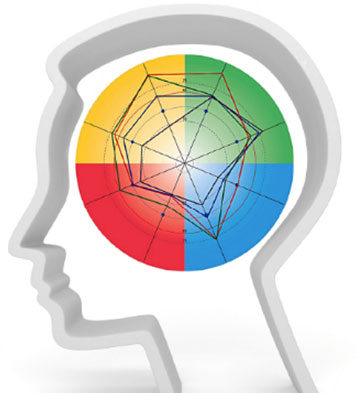PRISM Brain Mapping – Behavior Adaptability Tool India
PRISM and psychometric instruments stem from two different sciences and direct comparison is akin to comparing apples and oranges; they have some factors in common, but also some very fundamental differences.
 Neuroscience is highly complex and its terminology is often difficult to comprehend. In essence, PRISM Brain Mapping’s goal is to make this complex information as practical and as easy to understand as possible. It is about enabling people with no neuroscientific background to understand and use some of the latest discoveries of brain science in their personal and business lives. In fact, neuroscience will only be truly useful in business if it can be understood by those using it.
Neuroscience is highly complex and its terminology is often difficult to comprehend. In essence, PRISM Brain Mapping’s goal is to make this complex information as practical and as easy to understand as possible. It is about enabling people with no neuroscientific background to understand and use some of the latest discoveries of brain science in their personal and business lives. In fact, neuroscience will only be truly useful in business if it can be understood by those using it.
To facilitate understanding, PRISM uses colours to illustrate the behaviour preferences. Although the PRISM model is a metaphor for brain functioning, the PRISM maps represent the dynamic interaction that takes place within the brain and is based on the principle that no one part of the brain does solely one thing and no one part of the brain acts alone. All our thoughts, emotions and actions are the results of many parts of the brain acting together.
‘Plasticity’ is the neuroscience term for the brain’s ability to change. At one time, it was believed and widely taught, that the adult brain could not change once a certain level of development had occurred. This ‘cradle to the grave’ approach taken by many traditional psychometric tests is now impossible to sustain in the light of neuroscience discoveries. Your brain is physically different today from how it was yesterday. That difference results from the effect of yesterday’s and today’s experiences, as well as the thoughts and feelings that you have entertained during the past 24 hours.
Adapting behaviour
Brain research has shown that people function best when they are able to make the most of their natural preferences and abilities. Adapting behaviour is the extent to which the person feels it necessary to modify their natural behavioural preferences on occasions when dealing with day-to-day life e.g. when they are at work. By comparing how the person prefers to behave and the extent to which he or she sometimes modifies that behaviour, the PRISM system can calculate how the person consistently tends to behave most of the time.
Dichotomous profiling
The inadequacies of dichotomous (contradictory) views of behaviour have long been recognized. Despite the best intentions of test publishers, many psychological instruments are used to describe people in terms of “either/or” e.g. Introvert v Extrovert. PRISM shows that human behaviour is not “either/or” and that people can, and do, exhibit opposite behaviours. For example, the way in which people behave at home is often very different from the way they behave at work.
Highly Reliable
PRISM has been subject of previous validity studies in in 2003, 2006-2007. The latest validity study in 2014 was designed to ensure PRISM is not culturally biased in favour of particular ethnic groups over others. The main focus of that study was to examine the factor structure and reliability of PRISM scales across a range of ethnic groups.
Click here to read the Validity Report.Internal consistencies for the four colours
| Factor | Cronbach’s alpha |
|---|---|
| Red | .942 |
| Green | .925 |
| Gold | .936 |
| Blue | .925 |
Internal consistencies for the eight sub-scales
| Factor | Cronbach’s alpha |
|---|---|
| Red – Focusing | .926 |
| Red – Delivering | .896 |
| Green – Innovating | .918 |
| Green – Initiating | .862 |
| Blue – Supporting | .887 |
| Blue – Coordinating | .881 |
| Gold – Evaluating | .860 |
| Gold – Finishing | .912 |
We’re here to help!
Now experience PRISM Brain Mapping online or
by connecting with us on
| Phone : +91 9819 714 238 | Skype : PRISM Brain Mapping | ||
| WhatsApp : +91 9819 714 238 | Email : info@prismbrainmap.com |
